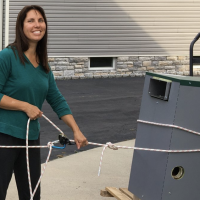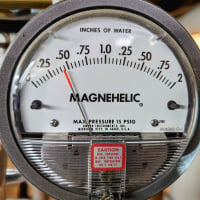Riser sizing.
General, non system specific question:
Lets assume the minimum size is sufficient for installed EDR.
Is there an advantage to upsizing longer risers (like to a 3rd floor) for at least part of the way and then reducing to the radiator size towards the end of the run?
In this case, the risers would be insulated so more of a flow rate question.
Seems that for 2 pipe, for example, it would help to make most of the run in 1" or even 1-1/4, then drop to 3/4 near the end.
What say you?
Comments
-
-
The Burnham Heating Helper says for steam risers for example they say :
25edr for 1"
55 for 1 1/4
85 for 11/2
150 for 2"
It says if the horizontal distance from main to riser is more than 10' go up 1 size
For mains the pressure drop should not exceed 2 oz
so 2" pipe @100 ft=350EDR for 200' edr is 235
2 1/2" 100 ft 580 edr 200ft 335 EDR
The above is for 1 pipe
Each job is different
You have to consider pitch, condensate flowing with or against steam 1 pipe or 2 pipe etc etc
See attached:
3 -
So, for 2 pipe, smaller is better just from a pipe heating angle? Makes sense
Trying to squeeze the best out of a Weil-McLain JB-5 running a 1912 1 pipe system.0 -
-
"Other problems "? Condensate?
Trying to squeeze the best out of a Weil-McLain JB-5 running a 1912 1 pipe system.0 -
-
-
That's what I was getting at. Seems there's something to it.
"It says if the horizontal distance from main to riser is more than 10' go up 1 size
For mains the pressure drop should not exceed 2 oz"
So long risers should be somewhat larger?
Trying to squeeze the best out of a Weil-McLain JB-5 running a 1912 1 pipe system.0 -
On my own single pipe system the horizontal runs appear to be kept larger even when the vertical runs are reduced. The vertical runs to radiators are a mixture of 1 1/4" and 1" but all of the horizontal runs are 1 1/4".
Single pipe 392sqft system with an EG-40 rated for 325sqft and it's silent and balanced at all times.
0 -
-
And in 2 pipe?
Trying to squeeze the best out of a Weil-McLain JB-5 running a 1912 1 pipe system.0 -
not sure. in 2 pipe there is still some condensate from the piping itself and it can connect in laterals, not really in risers. but that is an interesting question about what happens when small amounts of condensate and steam collide and how much cross sectional area is needed to make it a minor local disturbance vs water hammer.
1 -
not sure. in 2 pipe there is still some condensate from the piping itself and it can
connectcollect in laterals, not really in risersFrom watching my glass headers I can say that it's likely that the fresh steam re-vaporizes a lot of condensate as it passes by.
If it's not able to re-vaporize all of it, yes it should collect where a lateral turns upward from being pushed by the flow of steam. Then it will get carried up to the radiator in the risers like how a coffee percolator works. It won't hammer because the condensate will be hot enough not to collapse the steam (contrary to popular opinion, hot condensate does not collapse steam. They co-exist). We see the same thing where there is a sag in a one-pipe system…after the steam heats up the water, the steam can pass through the water. And we also see it in a pot of boiling water, and in all of the boilers in the world.
Any water that makes it up to the radiator is then in good shape, as it will flow down to the trap with all the rest of the condensate from the radiator.
Any water that is still in a lateral at the end of a call for heat will counter-flow back to the boiler no problem.
All these statements are for more-or-less typical scenarios, not for crazy-a** s*** that might be out there.
NJ Steam Homeowner.
Free NJ and remote steam advice: https://heatinghelp.com/find-a-contractor/detail/new-jersey-steam-help/
See my sight glass boiler videos: https://bit.ly/3sZW1el0 -
if there is a fitting transition that isn't exactly smooth or a little bit of sag that water will be there as the system is heating too, before it is steam hot.
0 -
-
I don't think it's consequential. If it were we'd all be hearing pinging and small banging as the main heats up along all its fittings.
NJ Steam Homeowner.
Free NJ and remote steam advice: https://heatinghelp.com/find-a-contractor/detail/new-jersey-steam-help/
See my sight glass boiler videos: https://bit.ly/3sZW1el0 -
i think that comes in to pipe sizing, there needs to be a certain cross sectional area compared to the water pocket so that it can dissipate rather than propel a slug of water.
0 -
There is no slug of water. Every main in the world has condensate running in it along with steam and no slug of water is ever created. The tiny bit of water that might be sitting in the seam of a fitting surely isn't going to add up to a "slug"
Surging is I guess what people think "slug of water" is.
Unless you are talking about a sag that makes a big pond of water that can collapse steam when hammer actually happens, but I don't think we're talking about that here.
NJ Steam Homeowner.
Free NJ and remote steam advice: https://heatinghelp.com/find-a-contractor/detail/new-jersey-steam-help/
See my sight glass boiler videos: https://bit.ly/3sZW1el0
Categories
- All Categories
- 87.3K THE MAIN WALL
- 3.2K A-C, Heat Pumps & Refrigeration
- 61 Biomass
- 429 Carbon Monoxide Awareness
- 120 Chimneys & Flues
- 2.1K Domestic Hot Water
- 5.8K Gas Heating
- 114 Geothermal
- 166 Indoor-Air Quality
- 3.7K Oil Heating
- 77 Pipe Deterioration
- 1K Plumbing
- 6.5K Radiant Heating
- 395 Solar
- 15.7K Strictly Steam
- 3.4K Thermostats and Controls
- 56 Water Quality
- 51 Industry Classes
- 50 Job Opportunities
- 18 Recall Announcements



